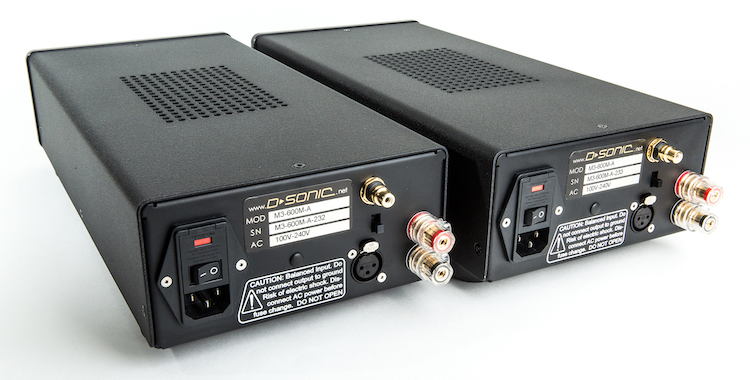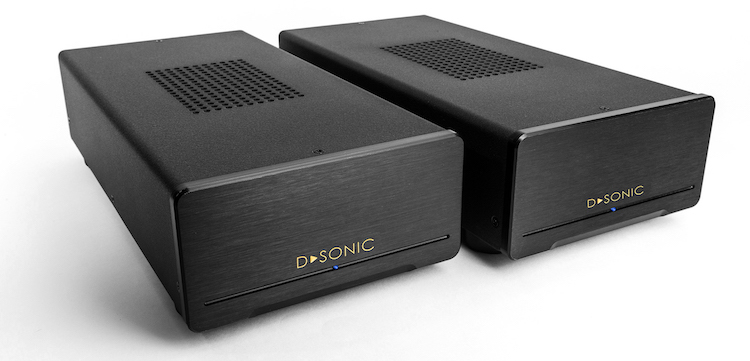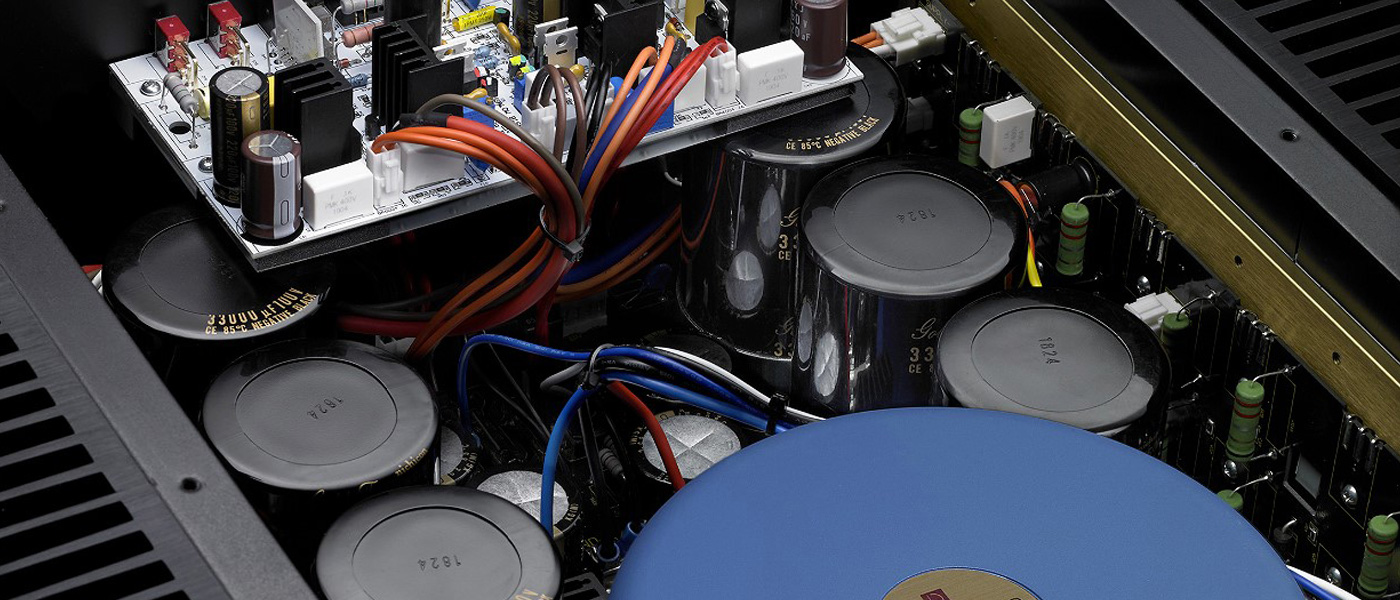
He sells them in mono and stereo configurations, in addition to three-, five-, and seven-channel amplifiers for home theater or professional sound applications. The D-Sonic amplifiers are modular, so Deacon can build a custom amplifier for you with any combination of one to seven channels with power from 400 to 1500 watts per channel.
D-Sonic M3a-600M Mono Amplifier
- Very attractive price-per-watt ratio
- Provides very fast and transparent sound with a seemingly endless amount of power in reserve
- Capable of capturing a surprising amount of low-level detail in recordings
- Produces prodigious power without getting hot, noisy fans, or pointy heat sinks
- RCA and balanced inputs add versatility
- Compact and easy to set up
- Very well constructed and supported by a full three-year warranty
Class D has hit its stride.
Here’s a quick history lesson, to demonstrate just how far the audio industry has come in the last four decades. The Grateful Dead’s “Wall of Sound” from 1974 comprised 48 McIntosh MC2300 amplifiers to deliver 26,000 watts of power. Each one of those amps weighed 128 pounds and cost $1800. So the McIntosh solution cost about $86,400 and weighed 6,144 pounds, roughly.
Secrets Sponsor
With D-Sonic’s solution, to get that much power with D-Sonic amplifiers you’d need only three seven-channel amps making 1,500 watts per channel for $4300 each, and those amps would weigh 56 pounds each; less than a third of a single MC2300. The overall D-Sonic solution for that much power costs $12,900 and weighs only 168 pounds. I think that’s an amazing technological advance. And in terms of cost-to-watt ratio, it’s amazing. And that’s not even taking into consideration the power consumption costs or the manpower to move all that equipment.

So here’s another history lesson. Back in the early 1990s, analog loyalist and Linn enthusiast Neil Young described listening to a CD as “ice cubes washing over you.” Over the years I have heard CD players and MP3 players that meet that description. And just recently I have heard other Class D amplifiers that also meet that description. And it’s fair to assume that a lot of sound reproduction enthusiasts tend to assume that digital sound will be cold and lifeless. A lot of my experience has proven that to be true, so even most contemporary components which use some sort of digital conversion in the audio path (DACs and amplifiers in particular) have a lot of prejudice to work against.
I am guilty of that prejudice. For the past twenty years, I have built a system around tube amplifiers built in the late 1960s and solid-state amplifiers built in the late 1970s. I am accustomed to the warm punchy sound from the solid-state amps and warm detailed midrange from the tube amplifiers. But the most power any of my amps produce is fifty watts, so what I am not used to is an amplifier having a firm grip on a woofer or producing effortless dynamics. I would like to have much, much more power to drive my speakers and have much more on tap for dynamics than I have now, but that would require tube amplifiers that command very high prices.
But I think the technology and engineering required for amplifier design and manufacturing to produce that kind of power has finally reached a point of affordability. Case in point: Dennis’s D-Sonic amplifiers. The M3a-600M amplifiers delivered all of that and more for me, and their selling price is affordable (and surprising, considering what they deliver). The M3a-600M mono amplifiers delivered fast, detailed, and seemingly limitless sound out of my system without a hint of digital harshness. No ice cube showers, no “digititis,” and no fatiguing harshness. I listened to them for days on end without ever wanting to change anything about them or getting tired of their sound.
But if you don’t believe me, you can try them out yourself. D-Sonic offers a 30-day trial period (which can even be extended, at Deacon’s discretion). If you don’t like them, just send them back and pay a 10% restocking fee (shipping is on you, both to and from).
A summary of the D-Sonic specifications follows; a document describing the specifications of his amplifiers in great detail is available.
CONFIGURATION:
D-Sonic proprietary UMAC Class D optimized amplifier power stages based on the Pascal X-PRO series amplifier modules
CHANNELS:
One per amplifier
PEAK OUTPUT VOLTAGE:
80V
PEAK OUTPUT CURRENT:
26A
INPUT IMPEDANCE:
60kΩ
OUTPUT IMPEDANCE:
6mΩ
VOLTAGE GAIN:
26dB SE mode, 32dB BTL mode
BANDWIDTH, UPPER:
70kHz
BANDWIDTH, LOWER:
.5Hz
THD+NOISE:
(1kHz @ 1 watt) 0.0045% / 0.003%
DYNAMIC RANGE:
120 db(A)
IDLE NOISE:
55 μV(A)
DAMPING FACTOR:
>1000
INPUTS:
Balanced (accepts XLR, balanced ¼”, unbalanced ¼”) and RCA
OUTPUTS:
One pair / 5-way binding posts
POWER EFFICIENCY:
88%
FRONT PANEL:
Blue LED when the amplifier is powered on
REAR PANEL:
IEC power cord socket
AC power rocker switch
XLR and RCA inputs
XLR and RCA input selector switch
12VDC trigger jack
DIMENSIONS:
7.25” wide x 4” high x 15” long
WEIGHT:
12.5 pounds
MSRP:
$1,075 each
Company:
SECRETS Tags:
D-Sonic, amplifier, monoblock, Class D, Amplifier Reviews 2019
The D-Sonic M3a-600M amplifier is enclosed in a rugged 14-gauge steel chassis with a black powder coat finish. The face plate of the amplifier is aluminum billet with a brushed anodized black finish. The brand’s logo is etched into the face of the amplifier and highlighted with warm gold paint. Directly below the company logo is blue LED power indicator light. Think of this as the signature look of D-Sonic. It is an understated and strong look, giving the amps an industrial look and the impression that they will stay strong for a very long time.

The D-Sonic M3a-600M amplifiers feature bullet-proof protection circuitry. The amplifier and your system are safe from shorting, over/under current conditions and thermal overheating. A D-Sonic amplifier will automatically power itself down and reactivate after it finds a short circuit or a current/thermal problem. And, to make it even safer, it will activate graceful, rounded wave forming if it clips, to prevent damage to your speaker drivers. So a D-Sonic amplifier will give your speakers a good workout but it will not damage them if your speakers are a reasonable power match. D-Sonic amplifiers are indeed gentle giants.
They run cool because they are 88+% efficient, so very little heat dissipation is necessary. And they feature medical-grade circuits to remove EMI and RFI interference from their AC power and signal circuits. All channels are true mono in that they only share grounding and AC line power. There’s also a 12VDC trigger input for a 1-to-3-watt standby mode.
Dennis utilizes the Pascal X-PRO Class D module in his D-Sonic amplifiers. And he has done his homework. He chose the Pascal module after reviewing several other Class D technologies. He started with common-sense design principles (high-quality components, good grounding, careful EMI/RFI protection and power supply design) and then iterated until he found the best circuit design to get the most out of the Class D module he thought sounded best.
OK, so let’s talk about the lifetime of an amplifier. We all know that with tube or solid-state amplifiers, the older they get the more likely it is that they will need capacitors, resistors, transformers, and whatnot replaced, either with NOS vintage or contemporary components. But those components are, for the most part, not particularly likely to see new development. We’re just not likely to see a new, radically different 6L6 power tube or metal film resistor anytime soon.
This is not the case with Class D amplifiers. There are a number of Class D modules available now (and there are many different schools of thought and implementation regarding every Class D module). Hypex, Pascal, ICEPower, Anaview are but just a few of these modules and each has its own fans and communities. And each module has its own development life cycle; in many ways, you can think of them in the same way you’d think about a computer’s central processing unit (CPU).
And much like the world of computers, there is a lot of research and development into new digital amplifier modules. Say that last year you bought a Windows laptop with an Intel i5 CPU. When the new, faster i9 processor is released, chances are good you can install the new processor in your computer. The same thing is happening with Class D modules; they are frequently updated. But Dennis is mindful of this situation and I don’t think he will leave you stranded with an inferior module if an upgrade is possible.
Dennis can upgrade any of his amplifiers built before 5/5/2017 using the current technology (after 2012). He redesigned the input circuit and will install a retrofit in your older amp. This tells me he is doing what he can to ensure his amplifiers always sound as best as they can.
All D-Sonic production models are assembled in the United States, and they utilize aerospace-quality switches, inputs, and outputs built to military specification. All wiring is silver/Teflon. And they come with a full three-year warranty. These things are built like tanks. In fact, I could easily imagine them being installed in an F-18 fighter plane.
Setting up the M3a-600M amplifiers couldn’t have been easier. Step one: feed it a signal input, either through RCA or balanced XLR cable. There’s a small black toggle switch between the inputs; push it toward RCA for that input, or toward XLR for that input. Easy. Step two: push your speaker cable banana plugs into the WBT terminals. Step three: plug in a power cable. That’s it, you’re done. The D-Sonic amplifier is ready to make music. Even though it won’t get particularly hot, you still want to give a D-Sonic amplifier some room to breathe, pretty much like any audio component.
If you’re building D-Sonic amps into a home theater rack, a rack mount kit is available for $97. This will enable you to install them into a standard rack rail system.
If you’re using the highest-powered D-Sonic amps, such as the M3a-3000S, M3a-5400-7 or M3a-6100-7, they can be configured to use dual power cords. This is recommended for when you’re using the amps in a professional setting and need that redundancy or performing a power test into a capacitive load.
Secrets Sponsor
After they’re wired into your system, you reach behind the amp and flip its toggle switch to power it on. Yeah, it would have been more convenient (for me and my big hands, at least) if the power switch were on the front of the amplifier. And yeah, that would also ruin the clean look of the face of the amplifier if the power switch were there. But I do not doubt there is a very good reason why the power switch is on the back, and I am sure it is based on sound engineering practice. Everything about these amplifiers, from the precision fit of the screws and connectors and body panels to the sturdy quality of the finish, prove to me that Dennis Deacon is building components to deliver optimal performance for a very long lifetime.
For my review, I connected the M3a-600M amplifiers to my Schiit SYS preamp. My two sources were my Oppo BDP-205 and my Ray Samuels Audio F-117 Nighthawk phono stage, which was driving the Denon DL-103 mounted on the Jelco tonearm of my Garrard 301. Speakers are my Spatial Audio M4 Triode Masters.
And how did my system sound with the D-Sonic amplifiers? As soon as I powered them on, I knew something special was happening. In fact, it took me a few days to begin to understand just how different my system had become with the D-Sonic amplifiers. And after a month, I was still being surprised.

My first surprise was just how much more of my Spatial Audio M4 Triode Masters I was hearing. Do you know how scientists always say we humans only use 20 percent of our brain? The M3a-600M amplifiers made me realize I had only been using 20 percent of my speakers. While I enjoy the warm and lively sound of the fifty watts per channel my McIntosh MC2505 feeds the speakers with, the sheer energy and power they portrayed when powered by the M3a-600M amplifiers was startling. The improvement in bass response, in particular, was very exciting. Finally, these speakers were getting the power and control they really need to sing. For the first time, I could see much deeper into the shape of the bass notes in the music; attack, decay, fret noise, all came into considerable focus. And with that came increased soundstage, both front-to-back and side-to-side. And that’s just what I noticed in the first hour of listening to these amps.
And it wasn’t just the bass. The midrange and upper frequencies of all music I listened to gained a precision and clarity I didn’t know possible with the speakers. Lyrics became easier to understand, especially with music that’s busy or has the vocals low in the mix. Because there was such improvement in the definition of distinct notes as they appeared next to other notes, there was improved clarity and distinction in the overall quality of the music. This was particularly exciting with movies. I also run my TV and movie watching through my main stereo, and the M3a-600M amplifiers made visual entertainment much more enjoyable.
The Spatial M4s are relatively easy to drive; in my review of them, I remarked how they sounded good with either a 2.5-watt tube amp or a 150-watt Class D amp. So it was easy to know the M3a-600M amplifiers would drive them well. But if you have speakers which present challenging loads or even woofers for that matter, the clean and prodigious sound of D-Sonic amps is what you want driving them. Planar speakers such as Magnepan or Martin-Logan, or massive woofers like those from REL are sure to benefit from D-Sonic amplifiers. D-Sonic amplifiers would be top on my list if I were building a home theater, that’s for sure.
It’s worth noting that I did not hear any change in sound quality with the M3a-600M amplifiers after they were powered on for a few hours. The amplifiers gave me their best quality as soon as they were powered on. And since I was using a passive amplifier, knowing I’d get best sound quality as soon as I turned on the system was another treat, as this is not something I get with my vintage gear.

This CD is a series of compositions on solo guitar recorded live. Basho-Junghans’s stream-of-conscious raga playing is meditative and sensitive. With the D-Sonic amps, I could very easily hear the differences between the steel 12-string and nylon 6-string guitars Basho-Junghans plays. The speed and accuracy of the amps let me hear more of the room, and finger movements, and the air within the guitars’ bodies and outside of their bodies as well.
I could easily picture the man sitting on a chair playing his guitar in my listening room. But more importantly, I could better hear the human flow of the music. Notes and finger manipulations were portrayed so quickly and correctly that the music did not suffer with regard to timing or distinction. It became much easier for me to forget the system and get lost in the music.

This is a mid-1990s progressive heavy metal masterpiece, and I listened to it with the Music On Vinyl 180gm vinyl reissue. At their core, Melvins is a three-piece rock band, so a system really needs a good handle on guitar, bass, and drums to portray the full impact of their music. The M3a-600M amplifiers didn’t even break a sweat.
The greasy tones of Buzz Osborne’s Gibson Les Paul, the different timbres of Dale Drover’s cymbals, and the full thud of Mark D’s bass guitar all came through. Melvins are also unusual in that they have a wicked sense of humor and can lock into a funky groove for a few bars here and there, and with the D-Sonic amplifiers, my system accurately portrayed the full humor and fun of these instances.
During bass-heavy sections I could easily hear the sound of the room and the microphone in front of the bass amplifier, giving me the full spectrum of the bass guitar performance. I could hear the different timbres of crash and splash cymbals, giving me a better understanding of what the drummer was trying to get across. The M3a-600M amplifiers gave me much more of the complete spectrum of the music, the performance, and the humans behind it all. And that was with no smearing at all of the notes’ timing that I could perceive.

This TV series is some of the best science fiction to come around in a very long time. Although it’s set in the future, it still follows the current laws of physics and mechanical engineering. There are no transporters, phaser beams, or faster-than-light drives. And the excellent sound design of the show obeys those facts.
The M3a-600M amplifiers brought a depth and realism to the show I had not experienced when listening to it with my vintage amplifiers. The sound of heavy-caliber ballistic rounds leaving a Gatling gun on a space ship and piercing the metal plating of another ship sounded exactly as I thought it would, with terrific impact and snap. It was very easy to distinguish how a human voice would sound in a small room on a space ship versus how it would sound in a helmet while floating in the vacuum of space. So many spatial clues became apparent that I was able to hear considerably more details about the show I’d missed before. And yes, explosions sounded great when the M3a-600M amplifiers were powering my Spatial M4 speakers.
The D-SONIC M3A-600M AMPLIFIERS deliver incredible sound quality and unwavering reliability for the price. Highly recommended.
- Amazing sound quality and power for the price
- Assembled in the US with excellent support and warranty service
- Very easy to install and implement
- Run cool but are very powerful
- Nothing, really. I can’t see how these can be improved.
The M3a-600M amplifiers deliver incredible sound quality and reliability for the price. They are built to last and Dennis Deacon provides excellent support. And if you have big, power-hungry speakers or subwoofers, the D-Sonic amps are sure to surprise you. Highly recommended.


